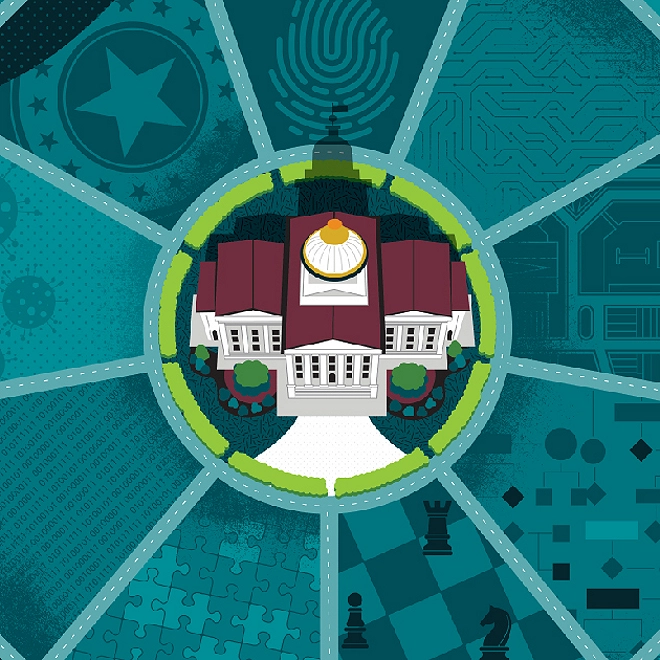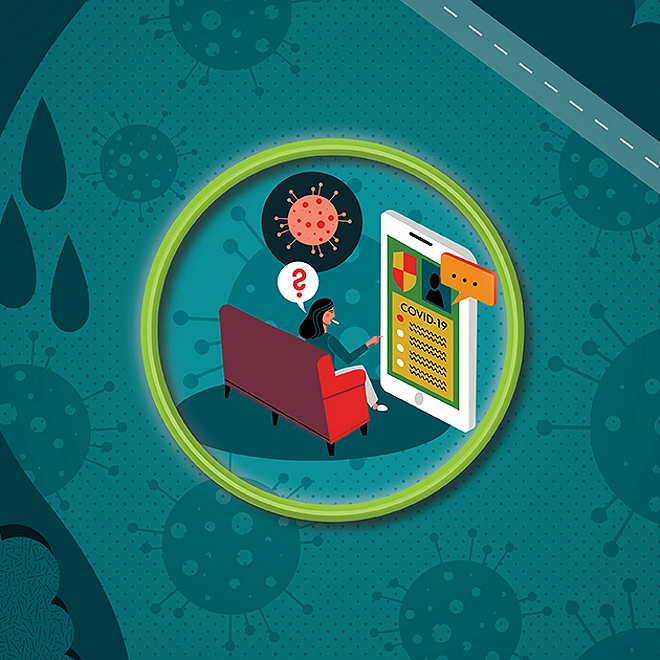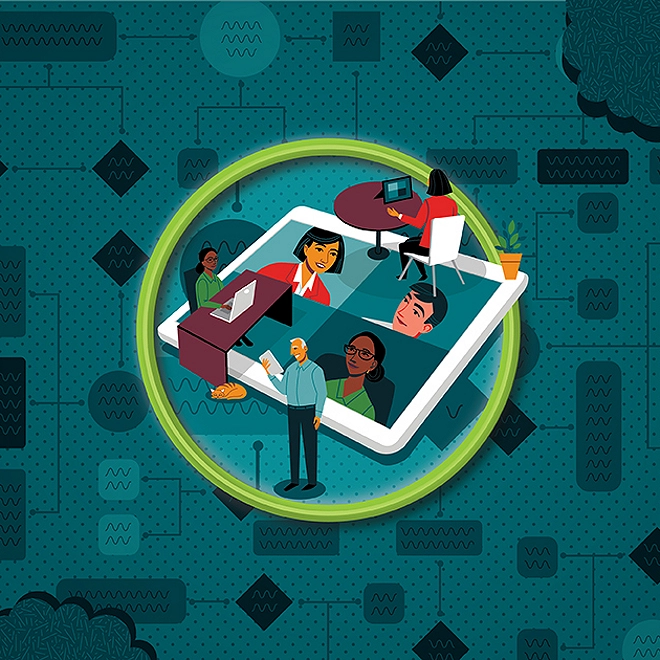Seamless service delivery
Personalized, frictionless, and anticipatory
Compared with the private sector, government is behind the curve when it comes to delivering a seamless digital experience. In 2019, 80% of federal agencies scored “poor” or “very poor” on Forrester’s US Federal Customer Experience Index, compared with only 14% of brands in the private sector.1 There is a sizable gap between the seamless digital experience customers have come to expect and the experience traditionally provided by the public sector.
What makes for seamless service delivery? Several things:
Personalized: The service is tailored to the individual’s needs, interests, and circumstances. The opposite of the “one-size-fits-all” mentality, the service provider makes an effort to really understand its customers and create a customized experience.
Frictionless: Accessing the service requires little to no effort on the part of the consumer—there are no hoops to jump through, no demands for information, no frustrating barriers. Think of “one-click” shopping or other apps that make it easy to get what you want fast.
Anticipatory: The provider anticipates what you want next and offers it proactively. Just as Netflix anticipates its viewers’ wants, queueing a new video as the credits roll, governments will need to deliver more seamless, personalized digital platforms that proactively serve citizen and business needs.2
The good news? Governments have been making huge strides in this area.
Governments move closer to a seamless digital experience
Recent years have seen significant progress in creating a seamless digital experience in government. Personalized services have spread across a number of government activities. South Carolina’s Department of Education has created an office dedicated to personalized learning.3 Educators in the state can now tailor their lessons based on individual student profiles.4 Some states also send automated, personalized reminders about benefit applications, upcoming renewals, or missing verification documents through the applicant’s preferred method of communication.5
Governments have been experimenting with frictionless services for at least two decades—Belgium ran a prefilled tax return pilot in 1995.6 But what was once niche is now becoming more common, as public agencies around the world seek to improve the customer experience. In 2019, the city of Stockholm, Sweden, introduced its Mobility-as-a-Service pilot project, UbiGo. Commuters can now connect to public transit, bike rental, car share, and taxi services through a single smartphone app.7 Thanks to this integrated app, citizens seamlessly access multiple transportation options and pay a single bill.
In terms of anticipatory government, in 2000, Estonia established a genomic database of health records and biological specimens for its population. An accompanying DNA analysis service informs citizens of which diseases they are susceptible to so they can take appropriate precautions.8 Indeed, many hospitals and other health care providers the world over are using precision medicine to help in the prevention of breast cancer and cardiovascular diseases.9
Without question, governments have been making great strides in leveraging technology to deliver a more seamless digital experience. Governments have the opportunity to go much farther, however. The real power of digital blossoms when you put all three aspects together: creating an experience that is personalized, frictionless, and proactive.
There are three main strategies that governments are taking to achieve this vision of seamless service delivery: committing to fully digital and touchless services, designing proactive services around life events, and building the infrastructure to support such seamless services.

Committing to fully digital and touchless public services
A total commitment to digital—in service design, back-end processes, and service delivery—can require rethinking virtually every aspect of public operations, challenging implicit orthodoxies.
We now have personal assistants that aren’t people, retail shopping without stores, and newspapers without paper. Fundamental questions are being asked: Does a workplace need to be a place? Do identification documents need to be documents? For example, some US states are using “no-touch” Medicaid eligibility determination for new applications and renewals. The system taps existing data about beneficiaries held by government, and caseworkers reach out to applicants only if any data is missing or documents need to be validated.10
Government appears on the verge of this shift. Indeed, the COVID-19 pandemic has accelerated the need for touchless services, as in-person interactions have become increasingly risky. From telework to telehealth to virtual courtrooms to the online approval of licenses and permits, governments are entering a new phase of a contact-free digital citizen experience.
Inspection: When COVID-19 forced lockdowns, Ontario’s Alcohol and Gaming Commission pivoted from in-person inspections to virtual inspections of cannabis stores. The agency has conducted hundreds of these virtual inspections since the onset of the pandemic.11 In the United States, Boulder, Colorado, has launched its own virtual building safety inspection service.12
Justice: Estonia has moved its court system online, allowing citizens to authenticate themselves and file cases via the country’s e-Justice platform. Courts can use the same platform to securely send signed, time-stamped, and encrypted documents to all parties involved in a case.13 In New South Wales, Australia, courts plan to continue to use virtual technology for direction hearings, appeals, and bail applications.14
Health: Many health care services have also shifted online. Some states in the United States developed a mobile application where the client can access, view, and use their Medicaid without the need for a physical card, and some others allowed the printing of Medicaid card by logging in online or through a mobile app.15 As coronavirus clusters emerged at health clinics and hospitals, Japan loosened its telehealth restrictions temporarily, allowing doctors to see first-time patients online.16 In the future, smart health monitoring could become increasingly important in a post–COVID-19 world. Hospitals, airports, and workplaces could passively collect and analyze body temperature measurements via 5G, for example.17
Committing to a digital mindset can eliminate the need for countless forms and reduce government interactions. Ironically, sometimes a “no-touch” approach can be the best way to connect with consumers of services.
Of course, the ultimate in “no-touch” service occurs when a service is delivered automatically—which is what the next approach is all about.
Designing proactive services based on life events
Governments have begun to further improve services by moving away from traditional department-based service delivery and toward a life-event approach. A life-event trigger does two critical things: First, it starts service delivery without the citizen necessarily needing to be involved. Second, it starts multiple types of services arising from a single life event.
Childbirth is a classic example of a life event that could trigger multiple government services, from health care to eligibility for family leave or other benefits—but it usually doesn’t. Today, the birth of a child can mean a slew of confusing paperwork for already-stressed-out new parents.
But this is changing. In Austria, for example, since 2014, the birth of a child triggers enrollment in the country’s family allowance program with no need for citizens to file a claim.18 The review process is automated via data transfers between hospitals, local tax offices, and other institutions, freeing up government staff to perform other tasks.19
Similarly, in 2019, Estonia developed an automated IT system that automatically fetches childbirth data from the government’s population registry each night. Parents deemed eligible for family benefits are sent an enrollment prompt. Confirmation takes less than a minute, and funds are automatically transferred to the family’s bank account.20
The automatic-trigger model can be applied to numerous life events, including job loss, retirement, injury or illness, home purchase, birth, death, or college enrollment.
Employment: Finland’s Aurora AI program uses AI to help residents undergoing job changes by consolidating government services and identifying which are most useful. For example, Aurora might recommend the most popular classes to a worker in need of retraining due to the pandemic.21
Starting a business: The New South Wales government offers a one-stop-shop portal for entrepreneurs looking to start a new business. The site outlines the costs, documents, legal requirements, taxes, and trademarks required to start a business.22 It also offers concierge services to help businesses identify license and permit needs, interact with other agencies, and assist businesses impacted by bushfires and COVID-19.23
Starting college: In the United States, college-bound students can apply online for financial aid in a 10-minute digital interaction. Tax information is pulled directly from the Internal Revenue Service, and students’ information is saved for next year’s application.24
Birth: In 2018, New Zealand launched its SmartStart tool, which allows new parents to access a broad range of services across government agencies via a single online portal. Parents can additionally request a digital identity to be used throughout the child’s life.25
Life triggers are the ultimate in proactive services, especially when the trigger integrates the back end, storing and analyzing data to predict when various services might be needed.26 Citizens often no longer need to apply for benefits, saving countless hours and improving government efficiency. But to achieve that type of seamless digital service requires a mature digital infrastructure—something that most governments are still working toward.
Building the infrastructure for seamless service delivery
As we’ve seen, personalized and frictionless services require strong data-sharing mechanisms. Moreover, data needs to be in a form that is compatible with sophisticated AI technologies to be able to anticipate service needs. Truly seamless services are often built on a digital platform and unique digital identities that enable a 360-degree view of citizen-consumers. Here are some key elements of the kind of deep digital infrastructure critical to delivering seamless digital services.
Digital experience: From the customer’s point of view, seamless means the service is accessible anywhere, anytime, and from any device. Seamless also means connected, creating an end-to-end digital experience. For example, in a majority of US states, residents can now use their Supplemental Nutrition Assistance Program benefits (formerly known as “food stamps”) to buy groceries online.27
Digital identity: A unique, uniform digital ID that grants agencies access to the appropriate data about a citizen or business is key to providing frictionless services. In India, Aadhaar, a unique digital ID, has been used to disburse COVID-19 cash relief. The Aadhaar-enabled payment system disbursed 280 billion rupees (US$3.8 billion) to more than 300 million beneficiaries during the lockdown.28
Data-sharing: Estonia’s X-tee platform allows for real-time data-sharing between public sector organizations, allowing for more effective, frictionless, and streamlined public services.29 The platform is also used by private sector organizations to exchange data. As many as 166 public institutions use X-tee to provide a range of services from filing taxes to verifying identity for social benefits.30
Intelligent technologies: Smart technologies such as AI can help government personalize service delivery. Estonia has relied on AI and machine learning technology to profile job candidates and recommend jobs for which they may be best suited. The job-matching program boasts a 72% success rate, compared with a 58% success rate for human employment advisers.31
Data signals
- More than 90% of Australians surveyed think governments “definitely” or “probably should” use the data within government to target resources to those who need it most.32
- During the COVID-19 pandemic, Finland has seen a 30% surge in public sector e-service usage.33
- Eighty percent of US public sector executives believe providing a unified customer experience has had a significant positive impact on their organization, and 67% of respondents report that digitized service delivery is a high priority for their organization in response to COVID-19.34
- Every Australian is expected to save eight hours by moving their transactions to digital government platforms.35
Moving forward
Shift from a government-centric to a citizen-centric lens. Tailor government standards and processes around citizen needs, not government silos.
Drive the adoption of digital identity with the intention to provide personalized service delivery.
Focus on using data to identify citizen needs and tailor government processes to deliver a consistent experience. Coordinate within and among agencies to share citizen data and provide seamless services.
Invest in digital experience platforms to support personalized citizen and business experiences.
Adopt integrated data management systems to promote the “once-only” principle that aims to ensure citizens and businesses need to provide information just once to government to avail multiple services.
Redesign service delivery process and workflows to integrate emerging technologies such as AI.
Bring a cultural shift to provide frictionless and personalized service delivery by embedding a customer-first mindset in the public sector. Part of this means rethinking the skill set of the public workforce.
Digital Customer Experience Services
Citizens’ demands are rapidly changing, and government customers want interactions to be on par with those they have in the private sector—mobile, innovative, and easy to use. As digital and
technology trends continue to evolve, a forward-thinking customer experience strategy can improve citizen engagement and put your agency at the forefront of innovation.



